Sony VPC-L117FX/B, VPC-L116FX/B, VPC-L116FX, VPC-L113FX/B, VPC-L113FX User Manual
...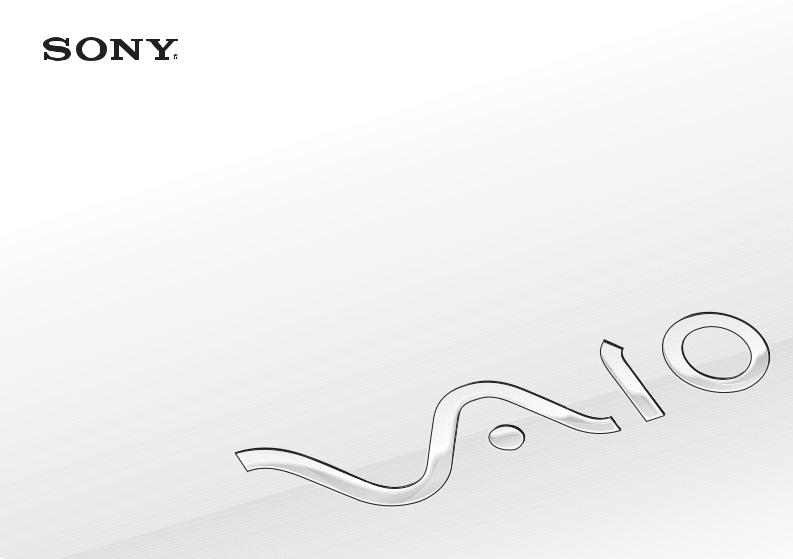
N
User Guide
Personal Computer
VPCL11 Series

n 2 N
Contents |
|
Before Use.......................................................................... |
4 |
Finding More about Your VAIO Computer .................... |
5 |
Ergonomic Considerations ............................................ |
9 |
Getting Started.................................................................. |
11 |
Locating Controls and Ports........................................ |
12 |
About the Indicator Lights ........................................... |
16 |
Setting Up Your Computer .......................................... |
17 |
Shutting Down Your Computer Safely ........................ |
25 |
Using the Power Saving Mode.................................... |
26 |
Updating Your Computer ............................................ |
28 |
Using Your VAIO Computer.............................................. |
29 |
Using the Keyboard..................................................... |
30 |
Using the Mouse ......................................................... |
36 |
Using the Touch Screen.............................................. |
42 |
Using the Built-in Camera ........................................... |
46 |
Using the Optical Disc Drive ....................................... |
47 |
Using the TV Function................................................. |
54 |
Using the HDMI/VIDEO Input Function....................... |
61 |
Using the Remote Commander................................... |
66 |
Using "Memory Stick".................................................. |
70 |
Using Other Modules / Memory Cards........................ |
76 |
Using the Internet........................................................ |
80 |
Using the Network (LAN) ............................................ |
81 |
Using the Wireless LAN............................................... |
82 |
Using the Bluetooth Function ...................................... |
85 |
Using Peripheral Devices.................................................. |
90 |
Connecting External Speakers or Headphones .......... |
91 |
Connecting an External Microphone ........................... |
92 |
Connecting a USB Device ........................................... |
93 |
Connecting an i.LINK Device....................................... |
95 |
Customizing Your VAIO Computer.................................... |
97 |
Setting the Password................................................... |
98 |
Using the VAIO Control Center ................................. |
103 |
Upgrading Your VAIO Computer..................................... |
104 |
Adding and Removing Memory ................................. |
105 |
Precautions ..................................................................... |
111 |
Safety Information ..................................................... |
112 |
Care and Maintenance Information ........................... |
114 |
Handling Your Computer ........................................... |
115 |
Handling the LCD Screen/Touch Screen .................. |
117 |
Using the Power Source............................................ |
118 |
Handling the Built-in Camera..................................... |
119 |
Handling Discs........................................................... |
120 |
Handling "Memory Stick" ........................................... |
121 |
Handling the Built-in Storage Device......................... |
122 |

n 3 N
Troubleshooting .............................................................. |
123 |
Computer .................................................................. |
125 |
System Security ........................................................ |
131 |
Built-in Camera ......................................................... |
132 |
Networking ................................................................ |
134 |
Bluetooth Technology ............................................... |
137 |
Optical Discs ............................................................. |
140 |
Display ...................................................................... |
144 |
Printing ...................................................................... |
146 |
Microphone ............................................................... |
147 |
Mouse ....................................................................... |
148 |
Speakers ................................................................... |
150 |
Touch Screen............................................................ |
151 |
Keyboard................................................................... |
152 |
Floppy Disks.............................................................. |
153 |
Audio/Video............................................................... |
154 |
HDMI/VIDEO Input Function ..................................... |
157 |
"Memory Stick".......................................................... |
159 |
Peripherals ................................................................ |
160 |
Trademarks..................................................................... |
161 |
Notice.............................................................................. |
163 |

Before Use >
n 4 N
Before Use
Congratulations on your purchase of this Sony VAIO® computer, and welcome to the on-screen User Guide. Sony has combined leading-edge technology in audio, video, computing, and communications to provide a state-of-the-art personal computing experience.
!
External views illustrated in this manual may look slightly different from those of your computer.
 How to find specifications
How to find specifications
Some features, options, and supplied items may not be available on your computer.
To find out about the configuration of your computer, visit the Sony online support web site at the following URLs:
For customers in USA http://esupport.sony.com/EN/VAIO/
For customers in Canada http://sony.ca/support/
For customers in Spanish-speaking Latin American countries or areas http://esupport.sony.com/ES/VAIO/LA
For customers in Brazil http://esupport.sony.com/BR/

Before Use > |
|
Finding More about Your VAIO Computer |
n 5 N |
Finding More about Your VAIO Computer
This section provides support information about your VAIO computer.
1. Printed Documentation
Quick Start Guide — An overview of components connection, set-up information, etc.
Safety Information — Safety guidelines and owner information.
2. On-screen Documentation
Help and Support — General information and technical assistance for your VAIO computer. To access Help and Support:
1 Click Start  and Help and Support.
and Help and Support.
2 Choose from the following categories to find the answers you need.
Get started with my VAIO |
Get help with Internet and wireless setup, security setup, personalizing your VAIO computer, and creating |
|
recovery discs and more. |
|
|
Use my VAIO |
Access interactive help in the form of VAIO tutorials, how-to articles, the VAIO technology page, |
|
specifications, and system and software information. |
|
You can find useful documentation such as below: |
|
- VAIO User Guide (This manual) |
|
- VAIO Recovery Center User Guide - Information about restoring individual software programs, |
|
hardware drivers, and drive partition(s) or your entire built-in storage device to the original factory settings |
|
- Software Information |
|
|
Troubleshoot my VAIO |
Maintain and troubleshoot your VAIO computer with VAIO Care, system restore, backup and recovery, and |
|
contact Sony support. |
|
|

Before Use > |
|
Finding More about Your VAIO Computer |
n 6 N |
Program help files — May be included with the preinstalled software programs on your computer. You may be able to access the help files from the help menu on a specific program.
SmartWi™ Connection Utility Help — Information about setting up Bluetooth®, wireless LAN, GPS, and wireless WAN functions.
Features and options may not be available on your computer.
See the specifications to find out about configuration of your computer.
To access this on-screen guide:
1 Click Start, All Programs, and SmartWi Connection Utility.
2 Click SmartWi Connection Utility Help.

Before Use > |
|
Finding More about Your VAIO Computer |
n 7 N |
3. Support Web Sites
Sony online support web site
The Sony online support web site provides instant access to information on commonly encountered problems. Type a description of the problem and the Knowledge Database searches for the corresponding solutions online.
For customers in USA http://esupport.sony.com/EN/VAIO/
For customers in Canada http://sony.ca/support/
For customers in Spanish-speaking Latin American countries or areas http://esupport.sony.com/ES/VAIO/LA
For customers in Brazil http://esupport.sony.com/BR/
Operating system online support web site
Your computer comes preinstalled with a Microsoft Windows operating system. For operating system support, you can visit Microsoft customer support at http://support.microsoft.com/directory/.

Before Use > |
|
Finding More about Your VAIO Computer |
n 8 N |
4. Customer Information Center
If you do not find the information you are looking for at our site, you may call Sony directly. You can find the contact numbers on the Sony online support web site. In order to receive the fastest and most efficient services, have the following information readily available:
1Your VAIO computer model
You can find it at the lower right corner of the display on the computer.
2Your computer's serial number
You can find it on the bottom, the back panel, or inside the battery compartment of your Sony VAIO computer. The serial number is the last 7 digits of the number below the barcode.
3The operating system on your computer
4The hardware component or the software program that is causing the problem
5A brief description of the problem
5. In Store Service & Support (available in USA only)
Make an appointment with a Sony certified technician at a U.S. Sony Style store and get personalized service and support for your VAIO PC. Sony Style Backstage Technicians can assist with the setup of your new VAIO PC, system optimization, data rescue, and any repair service you might need.
Visit the web site at www.sonystyle.com/backstage to find the nearest location.

Before Use > |
|
Ergonomic Considerations |
n 9 N |
Ergonomic Considerations
Whenever possible, you should attempt to take account of the following ergonomic considerations:
Position of your computer – Place the display directly in front of you. Keep your forearms horizontal, with your wrists in a neutral, comfortable position while using the keyboard or the pointing device. Let your upper arms hang naturally at your sides. Take frequent breaks while using your computer. Excessive use of the computer may strain eyes, muscles, or tendons.
Furniture and posture – Sit in a chair with good back support. Adjust the level of the chair so your feet are flat on the floor. A footrest may make you more comfortable. Sit in a relaxed, upright posture and avoid slouching forward or leaning far backwards.

Before Use > |
|
Ergonomic Considerations |
n 10 N |
Viewing angle of the display – Use the display's tilting feature to find the best position. You can reduce eye strain and muscle fatigue by adjusting the tilt of the display to the proper position. Adjust the brightness level of the display as well.
!
While adjusting the viewing angle, do not exert excessive pressure on your computer to eliminate a risk of mechanical damage.
Lighting – Choose a location where windows and lights do not cause glare and reflection on the display. Use indirect lighting to avoid bright spots on the display. Proper lighting adds to your comfort and work efficiency.
Ventilation – Make sure you leave at least 4 inches (10 cm) of space behind and at least 8 inches (20 cm) of space on each side of the main unit.

Getting Started >
n 11 N
Getting Started
This section describes how to get started using your VAIO computer.
!
Before starting your computer for the first time, do not connect any other hardware that did not originally come with your computer. Upon completion, connect one device (for example, a printer, an external hard disk drive, a scanner, and so on) at a time, following the manufacturer's instructions.
Locating Controls and Ports (page 12)
About the Indicator Lights (page 16)
Setting Up Your Computer (page 17)
Shutting Down Your Computer Safely (page 25)
Using the Power Saving Mode (page 26)
Updating Your Computer (page 28)
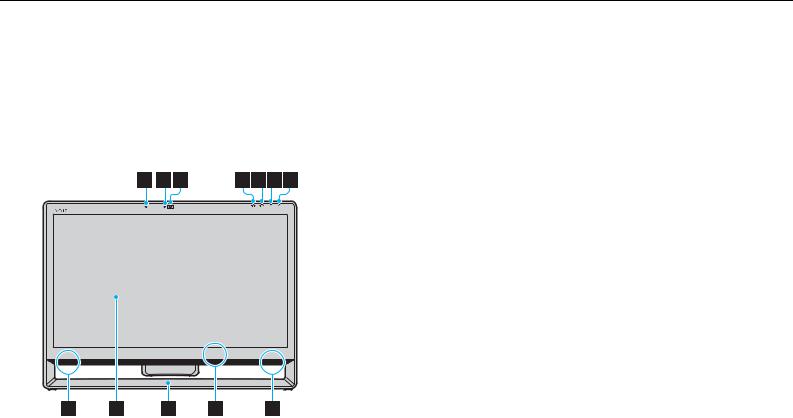
Getting Started > |
|
Locating Controls and Ports |
n 12 N |
Locating Controls and Ports
Take a moment to identify the controls and ports shown on the following pages.
!
The appearance of your computer may be different from those illustrated in this manual due to variations in specifications. It may also vary in some countries or areas.
Front
A Built-in microphone (monaural)
B Built-in MOTION EYE camera indicator (page 16)
C Built-in MOTION EYE camera (page 46)
D HDMI/VIDEO input indicator* (page 16)
E WIRELESS indicator (page 16)
F Disc drive indicator (page 16)
G Power indicator (page 16)
H Built-in speakers (stereo)
I LCD screen/touch screen (page 42)
!
Due to the mechanical design of the touch screen of your computer, some areas of the screen surface may become warm while you are using the computer for an extended period of time. This is normal and does not indicate a malfunction.
J Bottom chassis frame (page 112)
K Remote sensor*
Point the supplied remote commander to this sensor for operations.
* On selected models only.
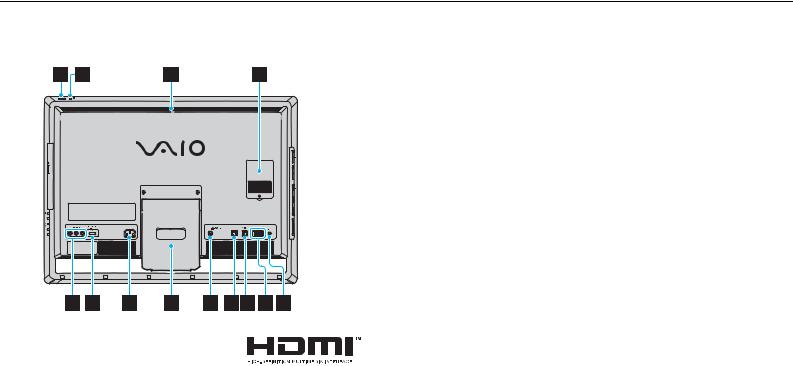
Getting Started > |
|
Locating Controls and Ports |
n 13 N |
Back
A Power button
B DISPLAY OFF button/DISPLAY OFF indicator (page 16) Press this button to turn off the LCD backlight. While the HDMI input or the video input is selected as the audio/video input source by the INPUT SELECT button (page 14), pressing this button also turns off the volume.
C Air exhaust vent
D Memory module compartment cover (page 105)
E VIDEO INPUT jacks*1 (page 61)
F HDMI INPUT port*1 (page 61)
G AC input port (page 17)
H Prop-up stand (page 112)
I CABLE/ANT (DIGITAL/ANALOG) input port*1 (page 54)
J Network (LAN) port (page 81)
K OPTICAL OUT port (page 91)
(Output Sampling Rate: 44.1 KHz/48.0 KHz/96.0 KHz)
L Hi-Speed USB (USB 2.0) ports*2 (page 93)
M CONNECT button (page 35), (page 39)
*1 On selected models only.
*2 Support high-/full-/low- speeds.
!
The area around the air exhaust vent (3) becomes extremely hot while your computer is on. Be sure to wait until the computer cools down before you touch it.

Getting Started > |
|
Locating Controls and Ports |
n 14 N |
Right
A Optical disc drive (page 47)
B Manual eject hole (page 140)
C Drive eject button (page 47)
D INPUT SELECT button* (page 63)/
INPUT SELECT indicator* (page 16)
E MENU button* (page 63)
F V/v (Up/Down) buttons* (page 63)
G OK button* (page 63)
* On selected models only.

Getting Started > |
|
Locating Controls and Ports |
n 15 N |
Left
A "Memory Stick Duo" slot*1 (page 70)
B Media Access indicator (page 16)
C SD memory card slot (page 76)
D i.LINK 4-pin (S400) port (page 95)
E Hi-Speed USB (USB 2.0) ports*2 (page 93)
F Headphones jack (page 91)
G Microphone jack (page 92)
H Line In jack
|
Connect an external audio device to receive audio signals. |
*1 |
Your computer supports only Duo-size "Memory Stick". |
*2 |
Support high-/full-/low- speeds. |

Getting Started > |
|
About the Indicator Lights |
n 16 N |
About the Indicator Lights
Your computer is equipped with the following indicator lights:
Indicator |
|
Functions |
|
|
|
Power 1 |
|
Illuminates in green while the computer is on, illuminates in orange while the computer is in Sleep mode, and |
|
|
goes out when the computer is turned off. |
|
|
|
HDMI/VIDEO* |
|
Illuminates in green while the HDMI input or the video input is selected as the audio/video input source. |
|
|
|
Built-in MOTION EYE camera |
Illuminates while the built-in camera is in use. |
|
|
|
|
Media Access |
|
Illuminates while data access to a memory card, such as "Memory Stick" and an SD memory card, is in |
|
|
progress. (Do not place the computer into Sleep mode or turn it off while this indicator light is lit.) When the |
|
|
indicator light is unlit, the memory card is not in use. |
|
|
|
INPUT SELECT |
* |
Illuminates in green while the HDMI input or the video input is selected as the audio/video input source. |
|
|
|
|
|
|
DISPLAY OFF |
|
Illuminates in orange while the LCD backlight is off. |
|
|
|
Disc drive |
|
Illuminates while data access to the built-in storage device or the optical disc drive is in progress. Do not place |
|
the computer into Sleep mode or turn it off while this indicator light is lit. |
|
|
|
|
|
|
|
WIRELESS |
|
Illuminates while one or more wireless options are enabled. |
|
|
|
*On selected models only.

Getting Started > |
|
Setting Up Your Computer |
n 17 N |
Setting Up Your Computer
Connecting a Power Source
You need a power cord to connect your computer to an AC power source.
Use only the supplied power cord for your computer.
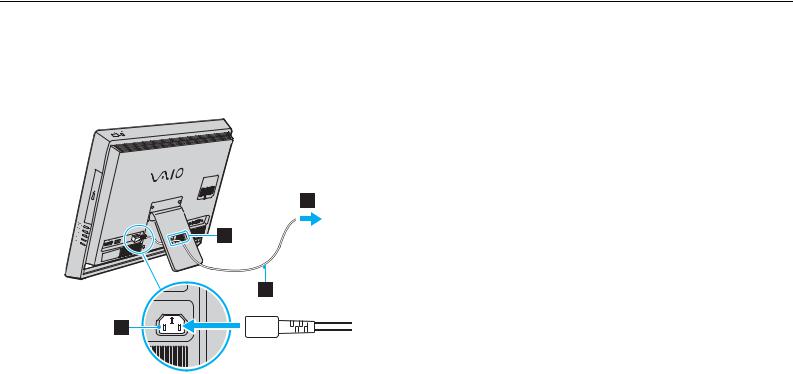
Getting Started > |
|
Setting Up Your Computer |
n 18 N |
To connect the power cord
1Plug one end of the power cord (1) into the AC outlet (2).
2Route the power cord through the hole (3) of the prop-up stand and plug the other end into the AC input port (4) on the computer.
To disconnect your computer completely from AC power, turn off the computer and unplug the power cord. Make sure that the AC outlets are easily accessible.
!
If you unplug the power cord from your computer while the computer is on or in Sleep mode, you may lose all unsaved data.

Getting Started > |
|
Setting Up Your Computer |
n 19 N |
Preparing for Wall Mounting
Four mounting studs and six screws, which are compliant with the Video Electronics Standards Association (VESA) mounting standard, are supplied with your computer for connecting the computer to your mounting system.
!
Before connecting your computer to your mounting system or changing your computer setup from the desktop type to the wall-mount type, make sure that:
The weight of your computer is within the range of supported weight of your mounting system. See the manual that came with your mounting system for the weight information.
A wireless connection is established both between the computer and the keyboard and between the computer and the mouse. If not, follow the instructions described in To connect the wireless keyboard (page 35) and To connect the wireless mouse (page 39).
You shut down the computer, turn off all peripheral devices, disconnect the power cord and the peripheral devices from the power source, and then wait about an hour until the computer cools down before proceeding.
While your computer is wall mounted, do not place any objects on top of your computer so as not to break the frame and cause the main unit to fall from the wall, resulting in damage to the computer or personal injuries.
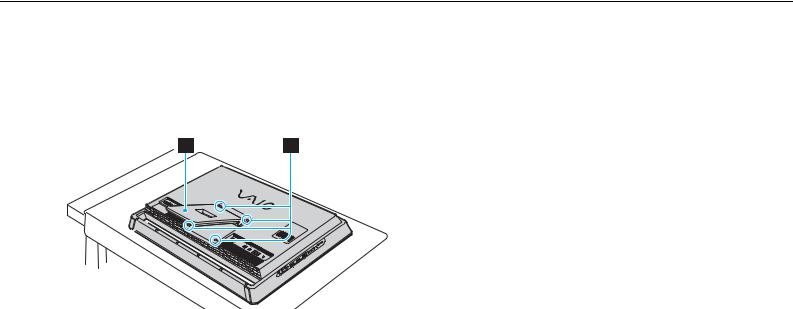
Getting Started > |
|
Setting Up Your Computer |
n 20 N |
To reveal the mounting holes
1 Gently face down your computer on a flat surface.
!
When facing down your computer, be sure to place it on a soft cloth to avoid damage to the screen frame.
2 Remove the four screws (1) and take the prop-up stand (2) off the computer.
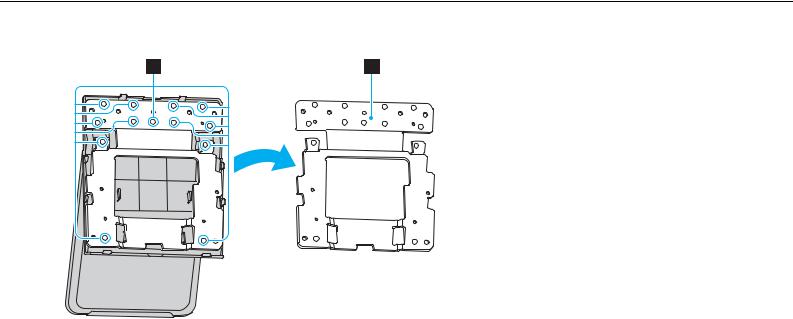
Getting Started > |
|
Setting Up Your Computer |
n 21 N |
3 Remove the 13 screws (3) from the back of the prop-up stand and take off the mounting base plate (4).
!
Be sure to keep the removed screws for future use.

Getting Started > |
|
Setting Up Your Computer |
n 22 N |
4Flip over the mounting base plate (5) and screw it onto the back of the computer using the four screws (6) that you removed in step 1.

Getting Started > |
|
Setting Up Your Computer |
n 23 N |
5 Secure the mounting base plate additionally with the supplied two long screws (7).
!
Be sure to tighten the screws with adequate torque.

Getting Started > |
|
Setting Up Your Computer |
n 24 N |
6 Screw the supplied four mounting studs (8) onto the mounting base plate.
!
Be sure to use the supplied accessory tool and tighten the mounting studs with adequate torque.
7 Secure your wall mount attachment to your computer with the supplied four short screws.
!
Do not use any screws other than the supplied ones.
8Follow the instructions described in the manual that came with your mounting system to mount your computer using the hole on each mounting stud.

Getting Started > |
|
Shutting Down Your Computer Safely |
n 25 N |
Shutting Down Your Computer Safely
To avoid losing unsaved data, be sure to shut down your computer properly, as described below.
To shut down your computer
1Turn off any peripherals connected to the computer.
2Click Start and the Shut down button.
3Respond to any prompts warning you to save documents or to consider other users and wait for the computer to turn off automatically.
The power indicator light turns off.

Getting Started > |
|
Using the Power Saving Mode |
n 26 N |
Using the Power Saving Mode
In addition to the normal operating mode, your computer has a distinct power saving mode called Sleep mode.
!
Turn off your computer if you do not intend to use it for an extended period of time.
Mode |
Description |
|
|
Normal mode |
This is the normal state of your computer while it is in use. The green power indicator light is lit while the |
|
computer is in this mode. |
|
|
Sleep mode |
Sleep mode turns off the LCD screen and places the built-in storage device(s) and the CPU into a low power |
|
consumption mode. The orange power indicator light illuminates while your computer is in this mode. |
|
|

Getting Started > |
|
Using the Power Saving Mode |
n 27 N |
Using Sleep Mode
To activate Sleep mode
Click Start, the arrow  next to the Shut down button, and Sleep.
next to the Shut down button, and Sleep.
Alternatively, you can press the sleep button on the wireless keyboard or the remote commander (if supplied) to place your computer into Sleep mode.
To return to Normal mode
Press any key on the wireless keyboard or the sleep button on the remote commander (if supplied).
Press the power button on your computer.
!
Make sure that the batteries of your wireless keyboard and remote commander (if supplied) are properly installed and not running out of power. If you press and hold the power button for more than four seconds, your computer will turn off automatically. You will lose all unsaved data.
If the computer is not used for a certain period of time, it will enter Sleep mode. To modify this, you can change the Sleep mode settings.
To change the Sleep mode settings
1Click Start, Control Panel, Hardware and Sound, and Power Options.
2Click Change plan settings under the current power plan.
3Change the time to place the computer into Sleep mode and click Save Changes.

Getting Started > |
|
Updating Your Computer |
n 28 N |
Updating Your Computer
Be sure to install the latest updates on your computer with the following software applications so that the computer can run more efficiently.
Windows Update
Click Start, All Programs, and Windows Update and then follow the on-screen instructions.
VAIO Update 4
Click Start, All Programs, VAIO Update 4, and Go to VAIO Web Support and then follow the on-screen instructions.
!
Your computer must be connected to the Internet to download the updates.

Using Your VAIO Computer >
n 29 N
Using Your VAIO Computer
This section describes how to get the most out of using your VAIO computer.
Using the Keyboard (page 30)
Using the Mouse (page 36)
Using the Touch Screen (page 42)
Using the Built-in Camera (page 46)
Using the Optical Disc Drive (page 47)
Using the TV Function (page 54)
Using the HDMI/VIDEO Input Function (page 61)
Using the Remote Commander (page 66)
Using "Memory Stick" (page 70)
Using Other Modules / Memory Cards (page 76)
Using the Internet (page 80)
Using the Network (LAN) (page 81)
Using the Wireless LAN (page 82)
Using the Bluetooth Function (page 85)
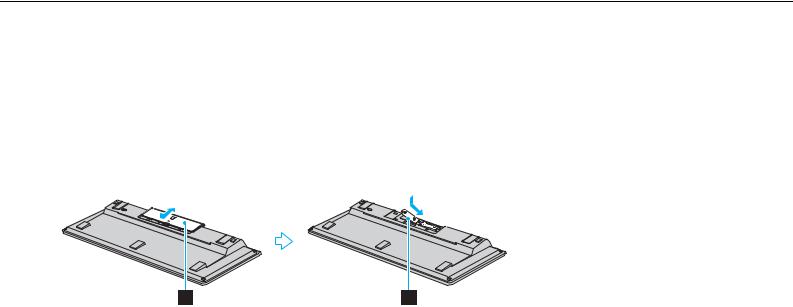
Using Your VAIO Computer > |
|
Using the Keyboard |
n 30 N |
Using the Keyboard
A wireless keyboard is supplied with your computer.
The wireless keyboard uses a standard key arrangement with additional keys that perform specific functions.
Using the Wireless Keyboard
Two AA alkaline batteries are supplied with your wireless keyboard. Before attempting to use the wireless keyboard, remove the battery compartment cover (1) from the bottom of the wireless keyboard and install the supplied two AA batteries (2) into the battery compartment.
If the wireless keyboard does not operate properly, the batteries may need to be replaced. If you do not intend to use the wireless keyboard for an extended period of time, remove the batteries to avoid possible damage from battery leakage.
If the wireless keyboard is left unused for 20 minutes or longer, your computer enters Sleep mode. To bring it back into Normal mode, press any key on the wireless keyboard.
